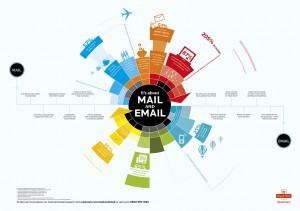 For most brands, email marketing is a critical component of the marketing plan and response rates and return on investment are scrutinized very closely. But are you analyzing response rates based on recipients’ email providers? According to new research by Chitika, you might want to start.
For most brands, email marketing is a critical component of the marketing plan and response rates and return on investment are scrutinized very closely. But are you analyzing response rates based on recipients’ email providers? According to new research by Chitika, you might want to start.
Depending on the web email provider a person uses, that person may be more likely or less likely to click on links in your email marketing messages. Furthermore, that person might be more or less likely to stay on your website after clicking through to it depending on the web email provider he or she uses.
The top web email providers in North America in March 2011 Yahoo! Mail. The market share breakdown is as follows (via eMarketer):
- Yahoo! Mail = 62%
- Windows Live = 27%
- AOL Mail = 7%
- Gmail = 4%
Separate research from other companies has revealed that Gmail has a much larger market share than the Chitika study claimed (closer to 30% market share). However, the demographics and behaviors of Yahoo! Mail versus Gmail users does not seem to change from one study to the next. Those demographics and behaviors follow:
- Gmail users tend to be younger than other web email users.
- Yahoo! Mail users are more likely to open and click on email marketing messages to visit the email message landing page.
- Gmail users are more likely to click through the email message landing page when they arrive on it than Yahoo! Mail users.
These findings tell marketers a few important things that you should be watching in your own brand email marketing campaigns. First, Gmail users may be more tech-savvy and are more choosy about which email marketing messages they actually open. Second, when you can convince a Gmail user to open and click through to your email landing page, you’re more likely to convert that visitor to a sale or reach your goal. The Chitika research showed that Gmail users are three times more likely to click through when they arrive at an email marketing landing page than Yahoo! Mail or Windows Live mail users are.
It’s interesting to think of different ways that you can slice and dice the demographic profiles and behavioral profiles of customers and email marketing message recipients. There may come a time when you reach a point in your analysis that you can delete specific web email providers from your email marketing list entirely. It’s something to think about.
Image: stock.xchng
Susan Gunelius is the author of 10 marketing, social media, branding, copywriting, and technology books, and she is President & CEO of KeySplash Creative, Inc., a marketing communications company. She also owns Women on Business, an award-wining blog for business women. She is a featured columnist for Entrepreneur.com and Forbes.com, and her marketing-related articles have appeared on websites such as MSNBC.com, BusinessWeek.com, TodayShow.com, and more.
She has over 20 years of experience in the marketing field having spent the first decade of her career directing marketing programs for some of the largest companies in the world, including divisions of AT&T and HSBC. Today, her clients include large and small companies around the world and household brands like Citigroup, Cox Communications, Intuit, and more. Susan is frequently interviewed about marketing and branding by television, radio, print, and online media organizations, and she speaks about these topics at events around the world. You can connect with her on Twitter, Facebook, LinkedIn, or Google+.


